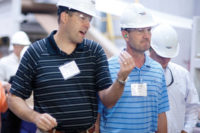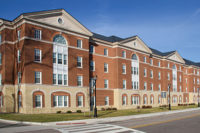Originally built by the Society of Dissenters in 1776, the Unitarian Church of Charleston story is as historic as it is imperative to this cultural South Carolina city. Documents report that before the construction was completed, the Brits utilized the house of worship as housing for its militia. More than a decade later, the church was officially dedicated in 1787 under the name The Archdale Street Meeting House.
Church member and architect Francis D. Lee was commissioned to enlarge and remodel the building in 1852. English architecture was the inspiration: a fan-vaulted ceiling, nave and chancel are named distant cousins to their English prototypes; the stained glass windows were considered exceptional by American standards. The style is referred to as English Perpendicular Gothic Revival. It has been suggested the UCC could have been the first Gothic architecture built in the United States.
One gets the point: This structure has importance as well as value. So, it could be assumed that any plasterer that specializes in restoration and preservation would covet a subcontract for any work on something this historic.
Enter Dillon Construction Services Inc., a South Carolina subcontractor based in Columbia and Charleston. This 25-year-old company has expertise in lime tuck pointing, brick replacement, brownstone repair, Terra Cotta repair, ornamental plaster restoration, flat wall plaster preservation as well as ornamental and flat wall plaster, Venetian plaster and Caenstone finishes. Stucco and EIFS are also services the company provides.
Craft Developing
The subcontractor’s President Kirk Dillon started in the trades 33 years ago in the field then worked his way up to project estimator, project manager and so on. Through talent, experience and hard work, he started his own firm in Columbia, S.C., eventually branching out to Charleston. With two offices in South Carolina, he has completed work on projects throughout the southeast and up and down the East Coast. Considering his specialty is footed in and around plastering so closely, situated along the eastern part of the country has its advantages. The company currently employs 30 people.
“I love the historic restoration work - the challenge of each project is unique and working in these structures is always exciting, making necessary repairs with materials available today, that people can look at it and they can see the structure as it was initially designed and envisioned,”says Dillon, sharing what he views as the most enjoyable part of the job. “There’s a lot of satisfaction in knowing that you were able to help take this structure and bring it back to its original condition. Working on such a multitude of different projects, each building is unique and provides new and engaging challenges. I absolutely love having the opportunity to work on some of the most awe inspiring historic structures but then to also work with individual clients who are engaging in new design and being able to help them realize their dream designs.”
He’s just as eager to share the parts of the job he doesn’t particularly enjoy. New regulations and excess paper work can be a drag, he says, adding that at times it could seem the paperwork and procedures take more time than he cares for.
“One of the other major challenges we face as a firm is competing and dealing with unqualified individuals on these types of projects due to the current economic climate,” Dillon says. “Historic restoration work takes a high degree of education and skill, and when times are hard, you oftentimes can get people bidding on projects that they aren’t qualified to be working on. I am sure there are many other companies around the country like us, who spend a lot of time and money to train and educate their teams and it can be disheartening to watch people come on a project and create greater issues for the structure or project by using incompatible materials or incorrect techniques.”
Fortunately, the days spent away from the field conducting the administrative duties has paid off. Dillon says the firm has a good work load on the books and it expects it to continue throughout the year.
The Demands of Historic Projects
For the Unitarian Church of Charleston project, Dillon Construction Services was contracted for two phases: Phase 1: stucco and steeple repair, and Phase 2: interior plaster restoration as a result of major termite damage.
As a restoration project, the focus was more on the integrity of the materials used rather than specific design elements of the walls. The ornamental plaster of the ceiling was a crucial aspect of the project that was focused on and took a great amount of time to complete and perfect, Dillon says.
“As well as the exterior steeple repair, which when we got into the project we discovered that there was a double set of steeples, the original and then a second steeple over the existing that at some point in the past 300 years had been erected but never tied on to the original foundation,”he says. In detail, DCS had a grocery list of services for this project according to DCS’s Superintendent Hank Bauer:
- The exterior stucco was inspected and all defective stucco was removed at which time it was discovered that many mortar joints and bricks had failed.
- All exposed mortar joints were cleaned back to 1 inches and tuck pointed with a matching historical mortar.
- All defective bricks were removed and replaced with a historical handmade replacement brick.
- The stucco replacement was a special historical correct mixture produced by A.W.Cook Cement Products Inc.
- Interior plaster was inspected for defective and failing plaster which was removed down to a sound area.
- All remaining historical fabric was retained in place and secured with plaster washers to the existing furring, metal lath was used as a plaster backing, and plaster patching was completed to match existing wall plane.
- Master of Plaster basecoat plaster was applied to all interior plaster walls and ceilings and mesh tape was used for all cracks and patch edges. A second coat was then troweled on smooth.
- The final finish coat was troweled smooth and reveals no patch ghosting of patches when painting was completed.
The subcontractor used South Carolina’s Master of Plaster Finishing Systems’Restoration Plaster product. It is an entirely organic and historically authentic slaked-lime plaster that DCS has used extensively throughout Charleston where preservation standards are so rigorous and stringent.
“(It’s) an amazing material that has allowed us to tie in any repair work seamlessly and truly restore these stunning walls and ceilings to their original glory,”Dillon says.
DCS developed a close relationship with the creator of the MOP line Mike Kempster. Roughly six years ago, Kempster was diagnosed with cancer. Dillon wanted to continue his friend’s legacy so he ended up purchasing MOP. Dillon’s daughter Lauren now runs this plaster outfit.
“A community’s architectural heritage is one of the main foundations on which future generations are able to stand and grow from and the fact that we are helping ensure these unique elements of our heritage are saved and that the skills to work on these structures is being passed on from one generation to the next is of utmost importance to us as a firm,”says Dillon.








Report Abusive Comment